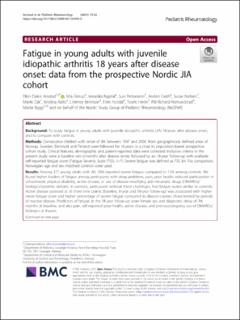| dc.description.abstract | Background: To study fatigue in young adults with juvenile idiopathic arthritis (JIA) 18 years after disease onset, and to compare with controls. Methods: Consecutive children with onset of JIA between 1997 and 2000, from geographically defined areas of Norway, Sweden, Denmark and Finland were followed for 18 years in a close to population-based prospective cohort study. Clinical features, demographic and patient-reported data were collected. Inclusion criteria in the present study were a baseline visit 6 months after disease onset, followed by an 18-year follow-up with available self-reported fatigue score (Fatigue Severity Scale (FSS), 1–7). Severe fatigue was defined as FSS ≥4. For comparison, Norwegian age and sex matched controls were used. Results: Among 377 young adults with JIA, 26% reported severe fatigue, compared to 12% among controls. We found higher burden of fatigue among participants with sleep problems, pain, poor health, reduced participation in school/work, physical disability, active disease, or use of disease-modifying anti-rheumatic drugs (DMARDs)/ biologics/systemic steroids. In contrast, participants without these challenges, had fatigue scores similar to controls. Active disease assessed at all three time points (baseline, 8-year and 18-year follow-up) was associated with higher mean fatigue score and higher percentage of severe fatigue compared to disease courses characterized by periods of inactive disease. Predictors of fatigue at the 18-year follow-up were female sex and diagnostic delay of ≥6 months at baseline, and also pain, self-reported poor health, active disease, and previous/ongoing use of DMARDs/ biologics at 8 years. | en_US |

